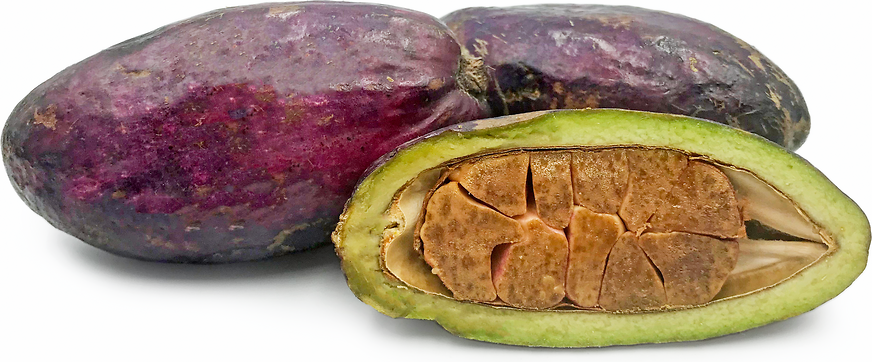


Safou Fruit
Estimated Inventory, lb : 0
Description/Taste
Safou fruit widely varies in size and appearance due to genetic variation and individual growing conditions. The fruit is generally oblong, oval, to conical in shape, averaging 4 to 15 centimeters in length and 3 to 6 centimeters in diameter, and is often found covered in scars and markings. The thin skin is shiny with a waxy coating and ripens from shades of pink or white to shades of violet, dark blue, to blue-black when mature. Each fruit may also bear multiple colors at one time giving the skin a variegated appearance. Underneath the skin, the smooth flesh also varies in hues of green, pale yellow, pink, to cream-colored, encasing a central seed that is light brown, oblong, dense, and firm. Safou fruit has a slippery consistency with a sour, mildly acidic, and tangy flavor when consumed fresh. The fruit also bears an aromatic fragrance similar to the scent of turpentine or citrus. When cooked, the fruit develops a buttery consistency with a milder, savory flavor.
Seasons/Availability
Safou fruit is available during the rainy season in Africa.
Current Facts
Safou fruits, botanically classified as Dacryodes edulis, are rare, nutritionally-dense fruits that grow on large evergreen trees and are members of the Burseraceae family. Native to tropical, humid regions of central and western Africa, Safou fruits have been cultivated and protected in villages, home gardens, and fields for thousands of years. The fruit is held in such high regard that even when clearing forests for farmland, the Safou fruit tree will not be harmed or cut down. Also known as Butterfruit, African Pear, Atanga, and Bush Butterfruit, Safou fruits are found in local African markets and are sold along roadsides as a midday snack. There are two varieties of Safou fruits, and both types carry a wide degree of generic variation, causing the fruits to be generally labeled under the name Safou. In the last decade, the fruit has been recognized for its nutritional properties and for its potential to become an exported crop.
Nutritional Value
Safou fruit is an excellent source of vitamins A and C and contains magnesium, potassium, and calcium. The fruit also contains a high oil content and a significant level of essential amino acids such as threonine, lysine, and leucine, which help the body perform all necessary functions including tissue repair, transporting nutrients, and digestion.
Applications
Safou fruits are best suited for both raw and cooked applications such as boiling or roasting. Typically served as a snack in between meals or mixed with other starchy ingredients for a main dish, Safou fruits have a pulp that is best consumed after heating. When fresh, the fruit is often set in a sealed container and placed in the sun to briefly warm before eating. While eating the fruit fresh can sometimes be an acquired taste, Safou fruit is more commonly consumed lightly boiled in saltwater. Once cooked, the flesh becomes soft and tender, the seed can be removed, and the fruit can be stuffed with cooked meats, spices, and vegetables. In Nigeria, the fruits are sold through street vendors boiled or roasted over charcoals, and the smooth pulp is often served with corn for added flavor. Boiled Safou fruits are also served with maize, plantains, or cassava in African home cooking to create a filling main dish. In addition to boiling, Safou fruits can be roasted with herbs and vegetables, or they can be cooked and pureed into a dip and served with crisps and chips. Safou fruits pair well with tomatoes, onions, garlic, ginger, parsley, rosemary, sausage, butternut squash, and sweet potatoes. The fruits are highly perishable and will only keep 1-5 days when stored in a cool and well-ventilated place.
Ethnic/Cultural Info
Researchers are looking to Safou fruit as a crop that can be utilized as a source of income for rural villages and as a sustainable food source to help solve the hunger crisis in Africa. In Nigeria, Safou fruit is historically one of the primary consumable food items that villages survive on during the “hungry season,” which is the time in between harvests and plantings. Providing an essential source of nutrients, Safou fruit can be consumed fresh, in cooked applications, or it can be pressed into healthy cooking oils that can be exported for sale to neighboring countries. Still remaining somewhat unknown in commercial markets, farmers, researchers, and Safou experts are joining together to form networks to advertise the fruit and educate rural farmers on the prospects of planting the fruit trees as a companion crop.
Geography/History
Safou fruits are native to humid, tropical forests in central and western Africa and have been cultivated by villages since ancient times. The fruits have primarily remained localized to Africa due to the lack of export infrastructure and are not commercially grown on a wide scale. Some growers are exporting Safou fruits to Europe for sale in specialty markets and can be found in countries such as the United Kingdom, Belgium, Switzerland, and France. The fruits are also cultivated on a small scale in Malaysia.
Recipe Ideas
Recipes that include Safou Fruit. One
| The Birth of a New African Cookbook |
|
Roast Tomatoes with Safou |




